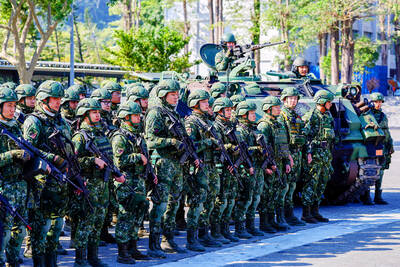Chinese Nationalist Party (KMT) Vice Chairman Hau Lung-bin (郝龍斌) yesterday said that the so-called “1992 consensus” is an indispensable precondition for a cross-strait peace agreement, while shrugging off reports of a divergence of opinions between KMT Chairwoman Hung Hsiu-chu (洪秀柱) and former vice president Wu Den-yih (吳敦義) on the political framework.
Hau made the remarks in an interview with former presidential office spokesman Fan Chiang Tai-chi (范姜泰基) on his online political talk show on Yahoo, one day after President Tsai Ying-wen (蔡英文) delivered her first Double Ten National Day speech.
“Beijing should face up to the existence of the Republic of China [ROC], as it is the best connection linking Taipei and Beijing,” Hau said, adding that goodwill on both sides of the Taiwan Strait is required for Beijing to accept that reality.
For Taipei, the greatest level of goodwill that Beijing has demonstrated is its promotion of the “1992 consensus,” a political framework that Tsai ought to accept, Hau said.
Hau said that since past experience has proved that “1992 consensus, with different interpretations” is conducive to cross-strait relations, Tsai will would see remarkable improvement in cross-strait relations simply by giving concrete emphasis to the framework.
The “1992 consensus” refers to a supposed understanding between the KMT and Beijing that both sides of the Strait acknowledge there is “one China,” with each side having its own interpretation of what “China” means.
Former Mainland Affairs Council chairman Su Chi (蘇起) said in 2006 that he had made up the term in 2000.
The KMT has maintained that the “different interpretations” is included in the “1992 consensus,” but Beijing has never acknowledged the existence of that element.
In both her inauguration address and National Day speech, Tsai expressed respect for the historical facts of the “1992 talks,” as opposed to official acknowledgement of the “1992 consensus” as Beijing would prefer.
As to views of Wu and Hung regarding the KMT’s new policy platform passed last month, Hau said that there is no difference in the pair’s conceptions of the “1992 consensus.”
“If both sides of the Taiwan Strait ever begin talks about inking a cross-strait peace agreement, ‘1992 consensus, with different interpretations’ will undoubtedly be a precondition,” Hau said.
The KMT’s new policy platform has been seen as an attempt by Hung to move the party closer to the concept of “one China, same interpretation,” as it only mentions the “different interpretations” part once when talking about former president Ma Ying-jeou’s (馬英九) success in deepening cross-strait interactions during his eight years in office.
It omits what the pan-blue camp has considered an integral element in the political framework in following mentions, with Wu saying on a recent visit to the US that the new platform could make it even harder for the KMT to survive.

UNILATERAL MOVES: Officials have raised concerns that Beijing could try to exert economic control over Kinmen in a key development plan next year The Civil Aviation Administration (CAA) yesterday said that China has so far failed to provide any information about a new airport expected to open next year that is less than 10km from a Taiwanese airport, raising flight safety concerns. Xiamen Xiangan International Airport is only about 3km at its closest point from the islands in Kinmen County — the scene of on-off fighting during the Cold War — and construction work can be seen and heard clearly from the Taiwan side. In a written statement sent to Reuters, the CAA said that airports close to each other need detailed advanced

Tropical Storm Fung-Wong would likely strengthen into a typhoon later today as it continues moving westward across the Pacific before heading in Taiwan’s direction next week, the Central Weather Administration (CWA) said. As of 8am, Fung-Wong was about 2,190km east-southeast of Cape Oluanpi (鵝鑾鼻), Taiwan’s southernmost point, moving westward at 25kph and possibly accelerating to 31kph, CWA data showed. The tropical storm is currently over waters east of the Philippines and still far from Taiwan, CWA forecaster Tseng Chao-cheng (曾昭誠) said, adding that it could likely strengthen into a typhoon later in the day. It is forecast to reach the South China Sea

Almost a quarter of volunteer soldiers who signed up from 2021 to last year have sought early discharge, the Legislative Yuan’s Budget Center said in a report. The report said that 12,884 of 52,674 people who volunteered in the period had sought an early exit from the military, returning NT$895.96 million (US$28.86 million) to the government. In 2021, there was a 105.34 percent rise in the volunteer recruitment rate, but the number has steadily declined since then, missing recruitment targets, the Chinese-language United Daily News said, citing the report. In 2021, only 521 volunteers dropped out of the military, the report said, citing

WEATHER Typhoon forming: CWA A tropical depression is expected to form into a typhoon as early as today, the Central Weather Administration (CWA) said yesterday, adding that the storm’s path remains uncertain. Before the weekend, it would move toward the Philippines, the agency said. Some time around Monday next week, it might reach a turning point, either veering north toward waters east of Taiwan or continuing westward across the Philippines, the CWA said. Meanwhile, the eye of Typhoon Kalmaegi was 1,310km south-southeast of Oluanpi (鵝鑾鼻), Taiwan’s southernmost point, as of 2am yesterday, it said. The storm is forecast to move through central